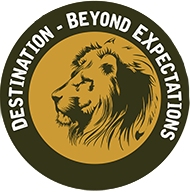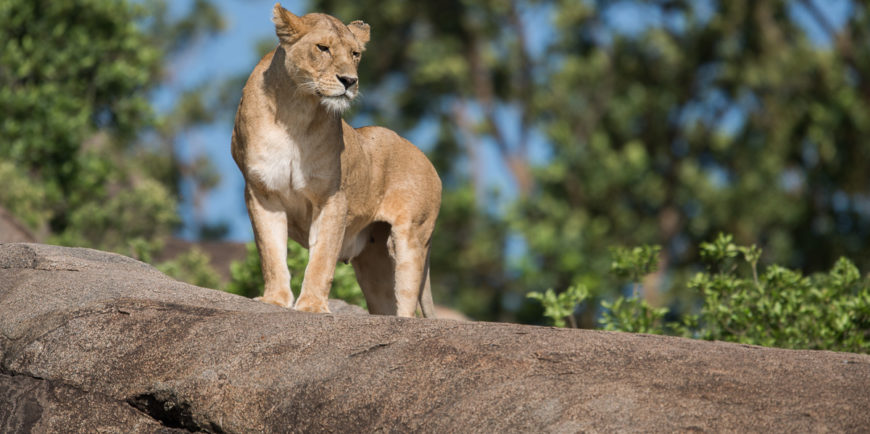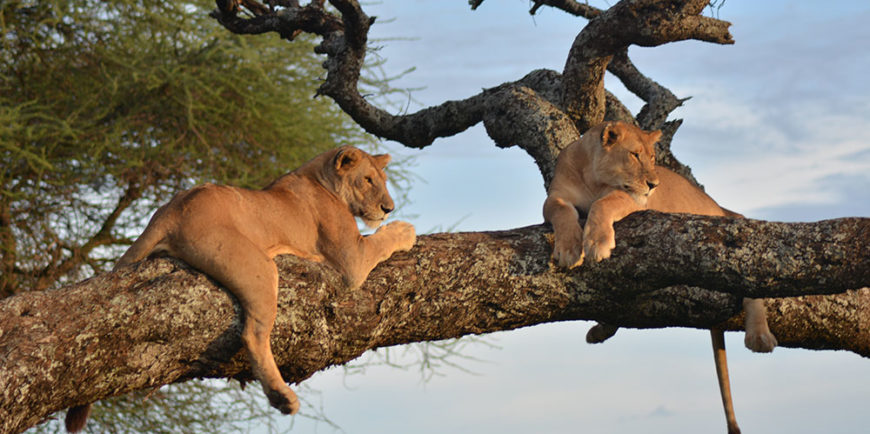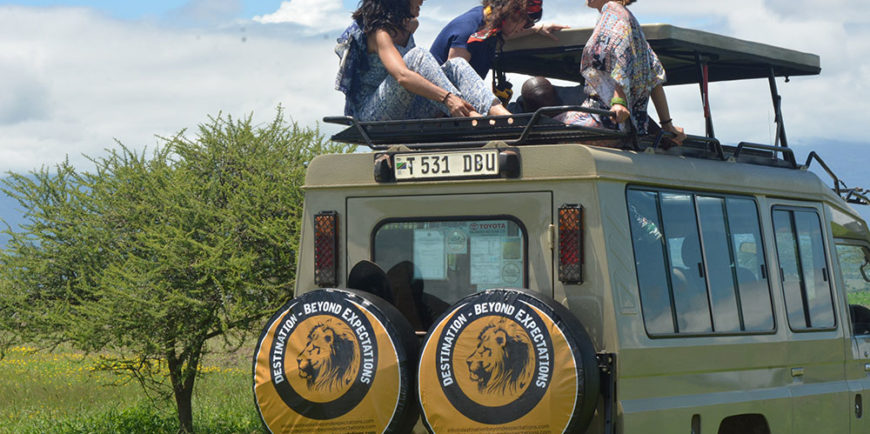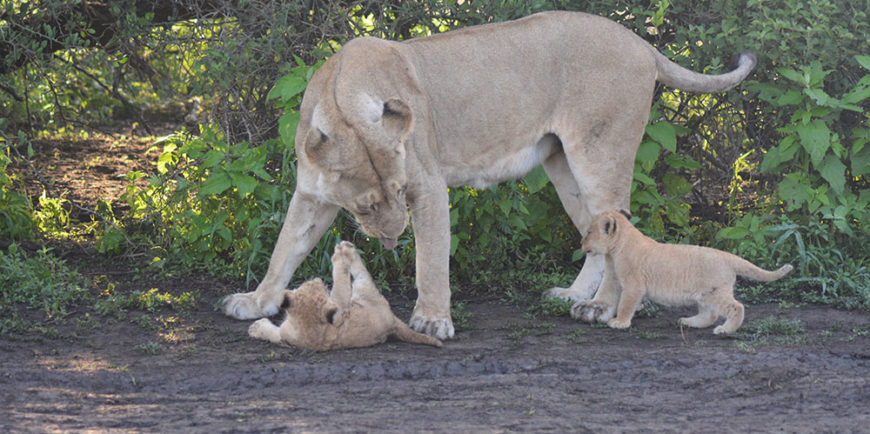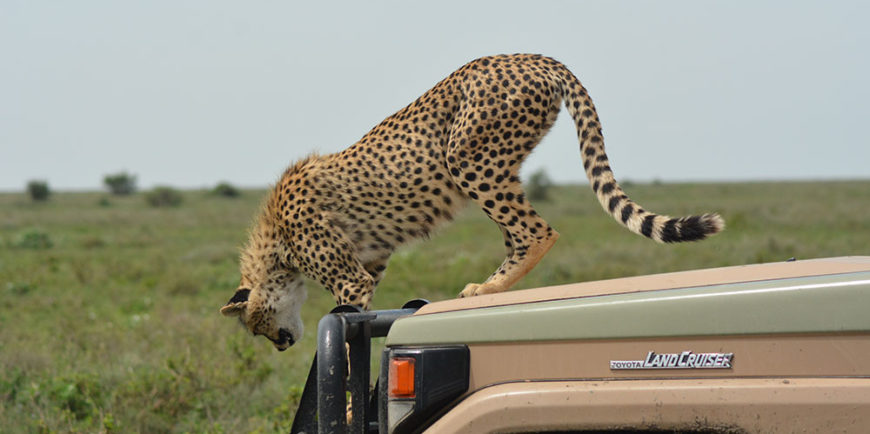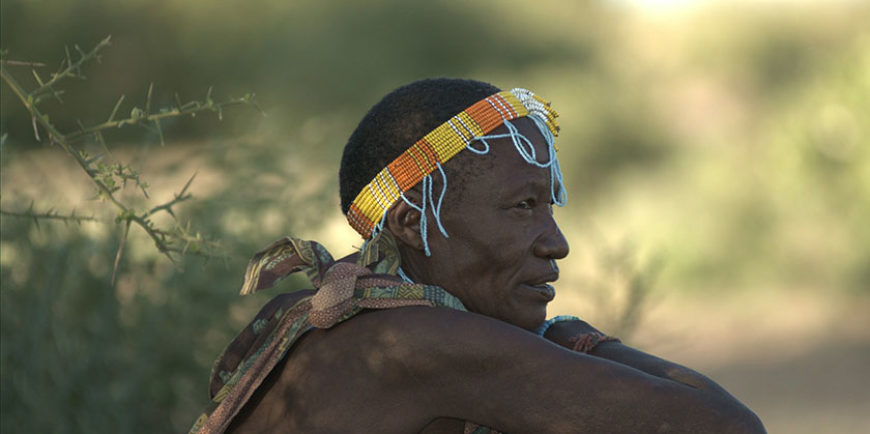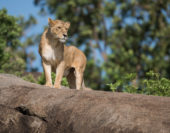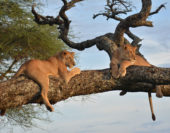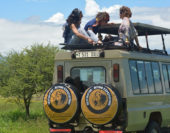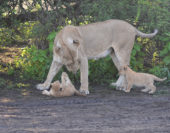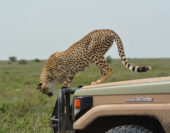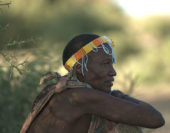BOOK THIS TOUR
Day 1
Arrival at Kilimanjaro airport overnight in Arusha (New Arusha Hotel, Lake Duluti Serena Hotel, Mt. Meru Hotel, Planet Lodge)
Day 2
Full day in Arusha sightseeing Museum, local market , visit coffee farms these are small scale farmers who own small pieces of land and locally process the coffee, Green vegetable garedens at Ilkidinga these are full day activities in Arusha . Have picnic lunch on one of the sites, dinner and overnight at the hotel.
Day 3: Depart from Arusha to Lake Manyara National Park
The compact game-viewing circuit through Manyara offers a virtual microcosm of the Tanzanian safari experience. Manyara provides the perfect introduction to Tanzanian’s birdlife. More than 400 species have been recorded; even a first-time visitor to Africa might reasonably expect to observe 100 of these in one day, including thousands of pink-hued flamingos, Pelicans, and Stokes. The park famous for tree climbing Lions depending on the season of the year, Migratory Elephants between Manyara and Tarangire, Cape Buffaloes, Hippos,m apes such as ,Baboons, Blue monkeys, and vervet monkeys, Giraffe , Impala. Afternoon drive to Shangrila coffee plantation, this is a big coffee plantation with modern machines for coffee processing.
Size: 330 sq km (127 sq miles) of which up to (77 sq miles) is a lake when water levels are high.
Location: In northern Tanzania, the entrance gate lies 1hr 30min (126km/80miles) west of Arusha close to the ethnically diverse market town of MtowaMbu.
To do: Game drives, canoeing when the water levels is sufficiently high. Walking along paddy (Rice) farm these are small scale farmers using irrigation scheme, Cultural tours, mountain bike tours, abseiling and forest walks on the escarpment outside the park.
Best time: Dry season (July-October) for large mammals; wet season (November-June) for bird watching, visit the waterfalls and canoeing.
Accommodation: One luxury Lodge Serena Manyara, Kirurumu Tented lodge, Lake Manyara Escarpment Lodge or Kilimamoja Lodge.
Day 4 & 5: After breakfast drive to Ngorongoro Conservation Area Authority
Ngorongoro is the world’s largest intact volcanic caldera, and its 304 sq km floor is the ultimate ‘Big Five’ destination, home of elephant, lion, leopard ,Black rhino, buffalo and others, the caldera holds over 25000 different species of animals, two main geological rifts through the area, Oldupai Gorge &Laitoli Foot Prints. Nine volcanoes in the Ngorongoro highlands were formed during the past 4 million years. One of these, OldoinyoLengai, is still active.
Size: 8288 sq km (3,200 sq miles)
Location: 180 km (112 miles) west of Arusha in the Crater Highlands area of Tanzania.
Getting there: The road from Arusha to the eastern entrance gate of the NCA via Makuyuni, MtowaMbu and Karatu is tarmacked and the trip can be covered comfortably in less than three hours, with another 30-60 minutes required to get to any of the lodges.
To do: Game viewing (and photography) enhanced by the striking backdrop of 600m-high crater wall, Cultural tours, visit to Oldupai Gorge, this is a historical site where the fossils of Hominid where found by Dr. Leakey in 1959. It is believed that the first upright man lived in this place.
Despite the fossils, the museum has a lot to see such as foot prints of upright man discovered at Laitoli, Stone Age tools, old animal bones and horns.
Accommodation: In Karatu a town before the entrance gate– Gibbs Farm, Bougainvillea, Tloma, Ngorongoro Farm House, Ollea Africana, or Mobile Camp. In the conservation area world-class game lodges perch grandly on the south-western crater rim such as Serena Ngorongoro, SopaNgorongoro, Ngorongoro Wildlife lodge, Ngorongoro Crater lodge, Ngorongoro Farm House, Valley Farm House.
Best time: Game viewing in the crater can be enjoyed, any time of the year. The wildebeest migration is in the NCA over December– April, calving January – February. For birders, November – March is best for Palearctic migrants.
Day 6: Early departure for Lake Eyasi
With breakfast basket for early hunting, gathering with Hadzabe /Bushmen/ Click speaking! This tribe still hunts with bows and arrows and collect honey from Baobab Trees and caves, women collect fruits, and dig up tubers, after these activities clients will test the hunt /meat in a barbeque while being entertained with traditional dance and songs Clients can also practice aiming with bow and arrow at baobab tree.
Visit of the Datoga Black smiths who make tools from old copper, silver, iron, and aluminum. They use local air compressor made out of animal skin and local air pipes made out of clay soil Things made out are such as Spear, arrow, Bracelet and many more if interested clients can buy to support the local community economy.
After all these activities, drive to Karatu town for lunch , afternoon visit school, walking along crater rim , visit Elephant cave, dinner and overnight at either of the hotels Gibbs Farm, Bouganvillea,Tloma , Ngorongoro Farm House.
Day 7: Depart for Maasai Boma/Laiboni
This is a medicine man who uses herbs from trees, grass, flowers to treat different diseases on adults and Children, Maasai people are Nilotic, Pastoralists/Nomads who migrated from Egypt following the Nile River basin with their animals. Maasai believe that all domestic animals belong to them.
This tribe practice norms, traditions and culture such as circumcision for boys age 10 to 14 without anesthesia neither stitches. Meat eating ceremonies whereby after slaughtering a big bull blood mixed with fresh milk and local alcohol will be taken by the elders –Men while fresh. Maasai men are polygamist, the more cattle, sheep and goats a man owns the more wives he can marry, clients will have a chance to see their life style, original maasai huts, dancing, live slaughtering and a test of barbequed goat.
Afternoon drive to Tarangire National Park.
Day 8 & 9: Tarangire National Park
You will spend 2 days in Tarangire National Park for game drive. Herds of up to 300 elephants scratch the dry river bed for underground streams, while migratory wildebeest, zebra, buffalo, impala, gazelle, hartebeest and eland crowd the shrinking lagoons. It’s the greatest concentration of wildlife outside the Serengeti ecosystem – a smorgasbord for predators-and the one place in Tanzania where dry-country antelope are observed decorated by over 250 years old Gigantic Baobab Trees
Size: 2,600 sq km (1,005 sq miles)
Location: 118km (75miles) south west of Arusha
Best time: Year round but dry season (June – September) for sheer numbers of animals.
Accommodation: Tarangire Safari Lodge, Sopa Tarangire, Roika, Maramboi Tented Camp or Lake BurungeTenteted Camp.
Day 10 Depart to Kondoa Ira
The Kolo sites BI, II, and III are especially amazing with vivid red colors of paintings and the Pahi site is interesting with its more recent black and white art. Following successes at the battles of Latema Nek and Kahe, Entente forces under the overall command of General Jan Smuts continued their advance southwards into German East Africa. By April 17, 1916, General Van Deventer’s 2nd Division had reached the vicinity of the town of KondoaIrangi – where they made contact with a unit of German Schutztruppe. The 2nd Division succeeded in pushing the enemy back, and captured the town on April 19. Entente casualties were minimal, whilst 20 Askari and 4 Germans were killed and 30 Askaris captured. Also found were 80 modern rifles with ammunition and a large herd of cattle. Despite low casualties, Van Deventer told the high command that the 2nd Division was exhausted and would be unable to continue the advance for some time. During its advance from Moshi, the division had lost more than 2,000 horses, mostly due to Tsetse fly. Smuts then ordered van Deventer to consolidate his position at KondoaIrangi, and reinforcements were brought up to aid this process. During this period, the rainy season began. This caused huge supply problems for the Entente force, as railway bridges were washed away by swollen rivers and roads became impassable. The 2nd Division was completely cut off, and was forced to scavenge for supplies around Kondoa. The result was a fall in health and morale.
Proceed driving to Dodoma city for accommodation at the Dodoma Hotel.
Day 11
After breakfast drive to the Vine yards, there are small scale farmers and big plantations owned by big companies. Visit Orange Farms, city Tour, Meals and overnight at the Hotel.
Day 12: Drive to Morogoro
Enjoying the scenery accommodation at Morogoro Hotel.
Day 13 & 14: Proceed to Mikumi National Park
The landscape of Mikumi is often compared to Serengeti. The road that crosses the park divides it into two areas with partially distinct environments. The area north-west is characterized by the alluvial plain of the river basin Mkata. The vegetation of this area consists of savannah dotted with acacia, baobab, tamarinds, and some rare palm. In this area, the furthest from the road, there are spectacular rock formations of the mountains Rubeho and Uluguru. The southeast part of the park is less rich in wildlife, and not very accessible.
The fauna includes many species characteristic to the African savannah. According to local guides at Mikumi, chances of seeing tree climbing lions is larger than in Manyara (famous for being one of the few places where the lions exhibit this behavior). The park contains a subspecies of giraffe, that biologists consider the link between the Masai giraffe and the reticulated or Somali giraffe. Other animals in the park are elephants, zebras, impala, eland, kudu, black antelope, baboons, wildebeests and buffaloes. At about 5 km from the north of the park, there are two artificial pools inhabited by hippos. More than 400 different species of birds also inhabit the park.
Accommodation at Vuma Hill Tented Camp.
Day 15, 16 & 17: Drive to Selous Game reserve
The Selous Game Reserve is one of the largest faunal reserves of the world, located in the south of Tanzania. It was named after Englishman Sir Frederick Selous, a famous big game hunter and early conservationist, who died at BehoBeho in this territory in 1917 while fighting against the Germans during World War I. Scottish explorer and cartographer Keith Johnston also died at BehoBeho in 1879 while leading a RSGS expedition to the Great Lakes of Africa with Joseph Thomson. The Selous was designated a UNESCO World Heritage Site in 1982 due to the diversity of its wildlife and undisturbed nature.
The reserve covers a total area of 54,600 km2 (21,100 sq mi) and has additional buffer zones. Within the reserve no permanent human habitation or permanent structures are permitted. All (human) entry and exit is carefully controlled by the Wildlife Division of the Tanzanian Ministry of Natural Resources and Tourism. Some of the typical animals of the savanna (for example elephants, hippopotami, African Wild Dog, Cape buffalo and crocodiles) can be found in this park in larger numbers than in any other African game reserve or national park.
Accommodation: Rufiji River camp, Sand River Camp, Impala Camp,Selous Safari Camp or,Mivumo Lodge.
Day 18
Drive to Dar-es-salaam city, for accommodation, Hyatt Regency Beach Hotel.
Day 19, 20 &21: Drive to Bagamoyo
Bagamoyo was the most important trading town of the east central coast of Africa in the late 19th century. Bagamoyo’s history has been influenced by Indian and Arab traders, by the German colonial government and by Christian missionaries. About 5 km (3 miles) south of Bagamoyo, the Kaole Ruins with remnants of two mosques and a couple of tombs can be dated back to the 13th century, showing the importance of Islam during the early Bagamoyo times. Until the middle of the 18th century, Bagamoyo was a small and insignificant trading center where most of the populations were fishermen and farmers. The main trading goods were fish, salt, and gum, among other things.
In the late 18th century Muslim families settled in Bagamoyo, all of which were relatives of Shamvi la Magimba in Oman. They made their living by enforcing taxes on the native population and by trading in salt, gathered from the Nunge coast north of Bagamoyo. In the first half of the 19th century, Bagamoyo became a trading port for ivory and the slave trade, with traders coming from the African interior, from places as far as Morogoro, Lake Tanganyika and Usambara on their way to Zanzibar. This explains the meaning of the word Bagamoyo (“Bwaga-Moyo”) which means “Lay down your Heart” in Swahili. It is disputed whether this refers to the slave trade which passed through the town (i.e. “give up all hope”) or to the porters who rested in Bagamoyo after carrying 35 lb cargos on their shoulders from the Great Lakes region (i.e. “take the load off and rest”). Since there is little evidence to support that Bagamoyo was a major slave port (Kilwa, much further south, has earned this status and that tens of thousands of porters arrived at Bagamoyo annually in the latter half of the 19th century, it is more likely that the name of the town derives from the latter interpretation.
Kaole Ruins
The slave trade in East Africa was officially prohibited in the year 1873, but continued surreptitiously well to the end of the 19th century. In 1868, Bagamoyo local rulers, known as majumbe, presented the Catholic “Fathers of the Holy Ghost” with land for a mission north of the town, the first mission in East Africa. This caused resistance by the native Zaramo people which was mediated by representatives of Sultan Majid and, after 1870, by Sultan Barghash. Originally the mission was intended to house children who were rescued from slavery, but it soon expanded to a church, a school, and some workshops and farming projects.
Bagamoyo was not only a trade center for ivory and copra; it was also a starting point for renowned European explorers. From Bagamoyo they moved out to find the source of the River Nile and explored the African inner lakes. Some of these were Richard Francis Burton, John Hanning Speke, Henry Morton Stanley and James Augustus Grant. Although often believed so, David Livingstone had never been to Bagamoyo in his lifetime. Only after his death he was laid out in the Old Church’s tower (nowadays named Livingston Tower) to wait for the high tide to come in and ship his body to Zanzibar.
Bagamoyo was the first capital of Tanzania while serving as the German headquarters of German East Africa (first under the auspices of the German East African Company and then the German Imperial Government) between 1886-1891. Dar es Salaam became the new capital of the colony in 1891. The town was apparently the (1895) birthplace of SS-Oberführer Julian Scherner. During World War I, on August 15, 1916, a British air attack and naval bombardment was launched on Bagamoyo, the Germans were overrun and the German garrison taken. When the German Empire decided to build a railway from Dar es Salaam into the interior in 1905, Bagamoyo’s importance began to decline.
Day 22
Drive to Dar-es-alaam for home Bound flight.
END OF THE SERVICE


